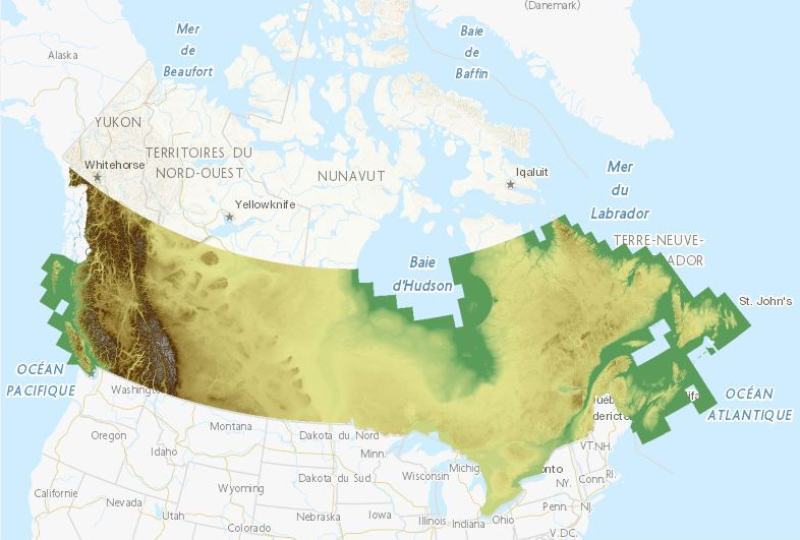relief
Type of resources
Available actions
Topics
Keywords
Contact for the resource
Provided by
Years
Formats
Representation types
Update frequencies
status
Service types
-
Yukon Shaded Relief
-
Created for distribution by the GeoYukon application as a comprehensive resource for all publicly available Elevation information in the Government of Yukon. This data may be used directly by other applications to dynamically display Yukon data; however, it may be subject to change as data sets are updated or added.
-

The Atlas of Canada's Relief Map shows Canada's relief with a colour ramp of elevation ranges. Colour tints of depth ranges show ocean bathymetry. This map shows the relief of Canada using three different resolutions. Starting with low resolution, as you zoom in, it transitions to medium and then high resolution. The low resolution is derived from the merging of Natural Resources Canada (NRCan) High Resolution Digital Elevation Model (HRDEM) from 2021 and the legacy Canadian Digital Elevation Model (CDEM), 1945-2011, resampled to 804 metres. The medium resolution is the NRCan, Medium Resolution Digital Elevation Model (MRDEM) from 2024, with modifications by the Atlas of Canada for cartographic purposes. The high resolution is NRCan's 2021 HRDEM product with 1 metre pixels. Also included, is a bathymetric layer from GEBCO 2021 (https://download.gebco.net/) resampled to 804 metre pixels. Other sources: Danish Ministry of Climate, Energy and Utilities; Geological Survey of Denmark and Greenland (GEUS) 2021; Government of Iceland; United States. National Geodetic Survey’s Integrated Database, 2021 (https://geodesy.noaa.gov/) All layers have been symbolized to match the Atlas of Canada Relief wall map. Copies of this map may be obtained from authorized map dealers in Canada, USA and abroad. For further information on purchasing the paper map MCR 0101 or downloading the digital version free of charge, go to atlas.gc.ca. Produced by the Canada Centre for Mapping and Earth Observation, Natural Resources Canada. Printed in 2025. ISBN 978-0-660-37948-7 Catalogue No. m57-1/46-2021e Permanent link: https://doi.org/10.4095/pe5mnk08hr Further information on all these maps can be found on the Atlas of Canada web site atlas.gc.ca.
-

Part of the Nova Scotia Topographic Database (NSTDB), DTM is a vector data set of spot elevations collected from aerial photography. An elevation point is collected at ground level approximately every eighty meters in an irregular grid pattern. These spot elevations, or mass points, can be used to create profiles of the ground or Digital Elevation Models (DEM). Data download also available via GeoNova: https://nsgi.novascotia.ca/WSF_DDS/DDS.svc/DownloadFile?tkey=fhrTtdnDvfytwLz6&id=37 Map Service view also available via GeoNova: https://nsgiwa.novascotia.ca/arcgis/rest/services/BASE/BASE_NSTDB_10k_DTM_UT83/MapServer?f=jsapi
-

This is a legacy product that is no longer supported. It may not meet current government standards. The Canadian Digital Surface Model (CDSM) is part of Natural Resources Canada's altimetry system designed to better meet the users' needs for elevation data and products. The 0.75-second (~20 m) CDSM consists of a derived product from the original 1-second (30 m) Shuttle Radar Topographic Mission (SRTM) digital surface model (DSM). In these data, the elevations are captured at the top of buildings, trees, structures, and other objects rather than at ground level. A CDSM mosaic can be obtained for a pre-defined or user-defined extent. The coverage and resolution of a mosaic varies according to the extent of the requested area. Derived products such as slope, shaded relief and colour shaded relief maps can also be generated on demand by using the Geospatial-Data Extraction tool. Data can then be saved in many formats. The pre-packaged GeoTiff datasets are based on the National Topographic System of Canada (NTS) at the 1:50 000 scale; the NTS index file is available in the Resources section in many formats.
-
The USGS Elevation Contours service from The National Map (TNM) consists of contours generated for the conterminous United States from 1- and 1/3 arc-second elevation data. Small scale contours derived from 1 arc-second data are displayed at scales ranging from 1:577K to 1:72K in The National Map viewer. Contour intervals are 100 foot between 1:577K and 1:144K, and 50 foot at 1:72K. Large scale contours derived from 1/3 arc-second data are displayed at 1:50K (and larger). Large scale contour intervals are variable across the United States depending on complexity of topography. The National Map viewer allows free downloads of public domain contour data in either Esri File Geodatabase or Shapefile formats. The 3D Elevation Program (3DEP) provides elevation data for The National Map and basic elevation information for earth science studies and mapping applications. Scientists and resource managers use elevation data for global change research, hydrologic modeling, resource monitoring, mapping and visualization, and many other applications. For additional information on 3DEP, go to http://nationalmap.gov/3DEP/.
-

This collection is a legacy product that is no longer supported. It may not meet current government standards. The Canadian Digital Elevation Model (CDEM) is part of Natural Resources Canada's altimetry system designed to better meet the users' needs for elevation data and products. The CDEM stems from the existing Canadian Digital Elevation Data (CDED). In these data, elevations can be either ground or reflective surface elevations. A CDEM mosaic can be obtained for a pre-defined or user-defined extent. The coverage and resolution of a mosaic varies according to latitude and to the extent of the requested area. Derived products such as slope, shaded relief and colour shaded relief maps can also be generated on demand by using the Geospatial-Data Extraction tool. Data can then be saved in many formats. The pre-packaged GeoTiff datasets are based on the National Topographic System of Canada (NTS) at the 1:250 000 scale; the NTS index file is available in the Resources section in many formats.
-

Terrestrial Ecosystem Mapping (TEM) project boundaries contains (study areas) and attributes describing each project (project level metadata), plus links to the locations of other data associated with the project (e.g., reports, polygon datasets, plotfiles, field data, legends).TEM divides the landscape into units according to a variety of ecological features including climate, physiography, surficial material, bedrock geology, soils and vegetation. This layer is derived from the STE_TEI_PROJECT_BOUNDARIES_SP layer by filtering on the PROJECT_TYPE attribute. Project Types include: TEM, NEM, TEMNSS, NEMNSS, TEMPRE, NEMPRE, TEMSEI, TEMSET, TEMTSM, TEMWHR, TEMSDM, TEMPRW, NEMPRW, and TEMSEW. Current version: v11 (published on 2024-10-03) Previous versions: v10 (published on 2023-11-14), v9 (published on 2023-03-01), v8 (published on 2016-09-01)
-

Terrain Mapping (TER) project boundaries contains (study areas) and attributes describing each project (project level metadata), plus links to the locations of other data associated with the project (e.g., reports, polygon datasets, plotfiles, legends) for terrain inventory, bioterrain and terrain stability mapping projects. TER divides the landscape into units according to surficial materials, landforms and geomorphological processes using the Terrain Classification System for British Columbia. This layer is derived from the STE_TEI_PROJECT_BOUNDARIES_SP layer by filtering on the PROJECT_TYPE attribute. Project types include: TEM, TEMNSS, TEMPRE, TEMSEI, TEMSET, TEMTSM, TSM, TSMREC, TSMDET, TIM, TBS, TBT, TIMSOI, TEMWHR, TEMSDM, TEMPRW, NEMPRW, and TEMSEW. Current version: v11 (published on 2024-10-03) Previous versions: v10 (published on 2023-11-14), v9 (published on 2023-03-01), v8 (published on 2016-09-01)
 Arctic SDI catalogue
Arctic SDI catalogue